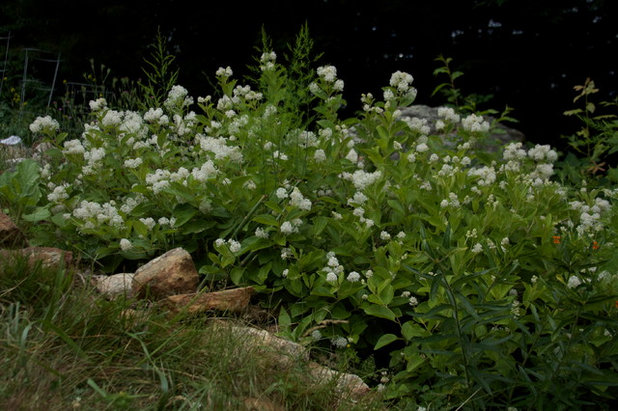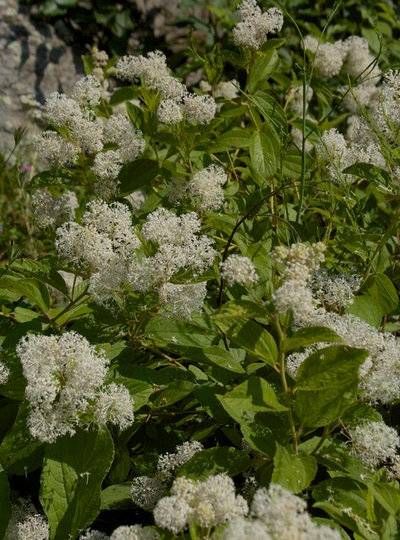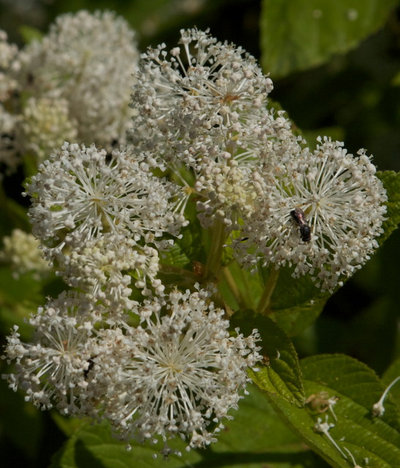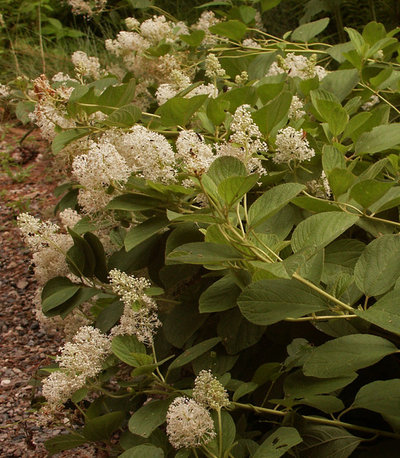New Jersey tea (
Ceanothus americanus) is a beautiful native flowering shrub rarely seen in the U.S. East, but it’s a valuable landscaping plant because it stays low without pruning and thrives in dry, lean or rocky soils. New Jersey tea is a plant for that full-sun area of your yard where nothing seems to grow well without constant watering and fertilizer. Its creamy white flower puffs bloom in early summer, attracting hordes of butterflies and beneficial insects — making this plant a must-have for butterfly gardens.

Ellen Sousa/Turkey Hill Brook Farm
Botanical name: Ceanothus americanusCommon names: New Jersey tea, redroot
Origin: Native to the eastern and northern U.S., west to Minnesota and south to Texas
Where it will grow: Hardy to -30 degrees Fahrenheit (USDA zones 4 to 9; find your zone)
Water requirement: None once established
Light requirement: Full sun or mostly sun
Soil requirement: Well-drained soil; thrives in sand and lean soils because of its ability to partner with natural soil bacteria to “fix” its own nitrogen.
Mature size: Forms a nicely dense and compact shape that never grows taller or wider than 2 to 3 feet; the stems may sprawl in richer soils with more moisture.
Benefits and tolerances: Its extensive root system helps stabilize steep slopes and sandy banks; it’s an important plant for butterflies, pollinators and beneficial insects.
Seasonal interest: Fluffy, fragrant flowers in spring and early summer
When to plant: Spring, to allow roots to establish before winter; the seeds require scarification (boiling water or heat or fire treatment) and cold stratification to germinate.
New Jersey tea is hard to find in general nurseries; look for it in native-plant nurseries.

Ellen Sousa/Turkey Hill Brook Farm
Distinguishing traits. When New Jersey tea is blooming, find a seat nearby and take some time to watch the show. Take some photos if you can. The blooms buzzing with pollination, prey and predators make a great teaching tool to illustrate how plants help nature stay healthy and balanced. Its foliage is a food plant for many butterfly and moth species, including the small but lovely spring azure, dusky wings, filament bearers and crocus geometers, to name a few.
The flowers are a popular nectar source for a huge variety of beneficial insects, including hover flies, nonstinging parasitic wasps, native solitary bees and a whole host of other species. Hummingbirds also dive in to feed on the numerous flower visitors. The flowers have the same blowsy look as the imported, more commonly grown Syringa lilacs — in fact, the western species of
Ceanothus is called wild lilac.

Ellen Sousa/Turkey Hill Brook Farm
How to use it. Plant a row of three as a low-maintenance foundation planting or along a woodland edge that receives spring and summer sunshine. It makes a good short hedge for an exposed area in full sun.
Pair New Jersey tea with yarrow (
Achillea spp), blanketflower (
Gaillardia spp), blazingstar (
Liatris spp), orange butterfly milkweed (
Asclepias tuberosa)
and other butterfly plants that love sun and good soil drainage. It grows well in the dry, acidic soil near pine trees. New Jersey tea is one of the few native shrubs suitable for Eastern meadowscapes, because it won’t grow too high and turn the meadow into a forest, and it can survive an occasional mowing.

Ellen Sousa/Turkey Hill Brook Farm
Planting notes. Severe winters and deer damage can cause stem die-back, but flowers form on new (first-year) stems, so New Jersey tea can be treated almost as a perennial. Choose your planting spot well, because its deep roots make it difficult to transplant. Deer eat the twigs and stems, which partly explains its rarity in the wild in the Northeast. Its preferred sandy, treeless habitat is favored for housing development, further explaining its rarity in wild populations.
New Jersey tea root is also known as redroot; its roots were used by Native Americans as medicine and dye, and the leaves were used by American colonists as a tea substitute — hence its common name. To try brewing your own New Jersey tea; pick the leaves when the plant is in full bloom.





